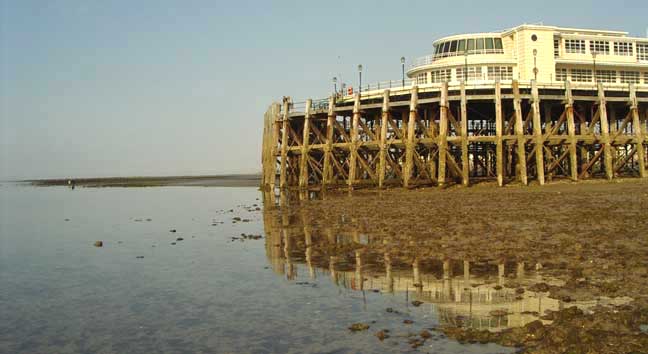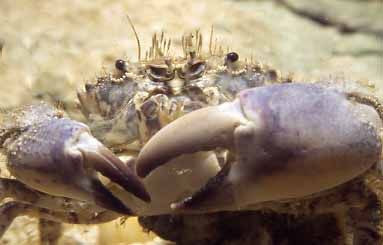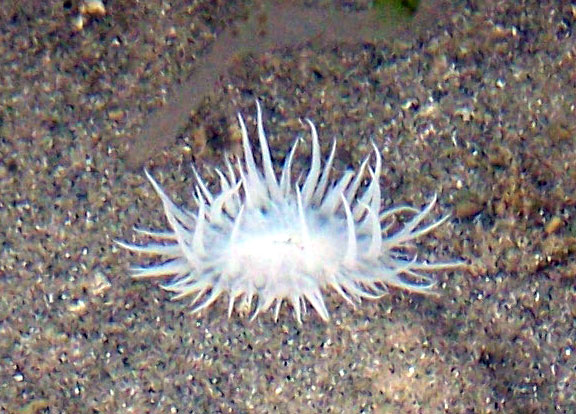 |
 |
 |
Lancing
Beach
Ostensibly
a sand and shingle beach, but the sea bed uncovered by the low spring tides
in places has a hard bedrock and loose rocks. Surprisingly, some of the
less common crabs have been discovered between the tides and two species
of sea anemones reach their eastern limit up the English Channel at Lancing.
One other small species of sea anemone Diadumene
cincta is recorded here and only a few
other places around Britain. Offshore it is a breeding area of the small
orange fish known as Montagu's Sea Snail,
Liparis
montagui.
 |
 |
 |
Worthing
Pier
The
rock and sand terrain beneath the amusement pier; at first glance, the
shore appears exclusively sandy and in all respects one of the least
promising of rockpooling shores. Firm sand leads
the explorer out to below mid-tide region where the sand gives away to
a mixed ground with rocks buried in the sand, a few looser rocks (cobble-sized),
and shallow sandy pools. Under the steel girders
of the pier is the best area, with the supports providing attachment points
of a sizeable
mussel community.
Worthing
Pier
Worthing
Pier on flickr
9
November 2007
 I
went for a long walk on the beach this morning and about 10
:00 am just as the tide was coming in and
was amazed by the large amount of dead and washed up Spider
Crabs, Maja
squinado, in one spot I counted 12,
I stopped counting at 26 as I walked from Lancing
Beach Green towards Onslow
Court. At one point one crab came washed up
and was still alive, the poor thing could hardly move so I picked it up
and popped it back into the water. The smallest I saw was about the size
of a tennis ball (the carapace) and the largest was the one I threw back
at about four tennis balls put in a square.
I
went for a long walk on the beach this morning and about 10
:00 am just as the tide was coming in and
was amazed by the large amount of dead and washed up Spider
Crabs, Maja
squinado, in one spot I counted 12,
I stopped counting at 26 as I walked from Lancing
Beach Green towards Onslow
Court. At one point one crab came washed up
and was still alive, the poor thing could hardly move so I picked it up
and popped it back into the water. The smallest I saw was about the size
of a tennis ball (the carapace) and the largest was the one I threw back
at about four tennis balls put in a square.
26
October 2007
A
seal, probably a Common (or Harbour) Seal,
Phoca
vitulina, was spotted off Lancing Beach
in the sea a 100 metres or so offshore at 8:00
am (tide level 2.2 metres, 2½ hours
after low on a spring tide). Its whole body
was seen and there could be no doubt about its identity.
About 10:30 am, there appeared to be about a dozen Turnstones on the same beach, but when disturbed a flock of about 35 rose and the flock swirled in a slight curve before settling thirty metres to the east. One Wheatear showed its white tail and there were a dozen plus Meadow? (or Rock) Pipits which occasionally perched on the wooden groynes. I looked out to sea for the seal, but I could only spot two Cormorants on the surface and actively diving under.
26
September 2007
My
visit was a bit briefer (30 minutes) than normal because the first spots
of rain were felt under a cloud, and it was breezy and the water felt just
slightly cold. A few Sanderlings
were disturbed on the sand by Onslow Beach,
east Worthing (TQ
170 028), just below the shingle.
 |
It
was fairly usual fare with common (100+) Snakelocks
Anemones,
Anemonia
viridis,
frequent Daisy
Anemones
Cereus
pedunculatus,
frequent sea anemones Sagartia
troglodytes, three Squat
Lobsters Galathea squamifera,
a few Edible Crabs Cancer
pagurus, occasional Hairy
Crabs Pilumnus hirtellus,
frequent Long-clawed Porcelain Crab Pisidia
longicornis and occasional Hairy
Porcelain Crabs Porcellana platycheles,
with a mating pair of Shore Crabs
Carcinus
maenas (the brown male was quite large but
the green female was small), a few
Prawns
Palaeamon serratus,
and a handful of two
large Chitons
(a mollusc in the class Polyplacophora)
probably Acanthochitona
crinita. More exceptional was a single
small Tompot Blenny, Parablennius
gattorugine, and one Arch-fronted
Swimming Crab Liocarcinus
arcuatus. A Long-legged
Spider Crab, Macropodia,
was discovered later.
Two
Common
Terns dived into the shallow water, their
identity guessed at my their feeding behaviour.
Two
Wheatears
flew over the shingle by the Golden Sands Caravan Park in Lancing.
1
September 2007
An
early morning visit to east Worthing beach produced the following:
Edible
Crab Cancer pagurus
Four
Shore
Crab Carcinus
maenas Eleven plus
Hairy
Crab Pilumnus
hirtellus Five
Short-legged
Spider Crab Eurynome
aspera One.
Long-legged
Spider Crab Macropodia
sp. Three.
Long-clawed
Porcelain Crab Pisidia longicornis Five
Squat
Lobster Galathea squamifera Seven.
 Hairy
Hermit Crab Pagurus cuanensis.
One.
Hairy
Hermit Crab Pagurus cuanensis.
One.
plus frequent sea anemones:
Snakelocks
Anemone
Anemonia
viridis 20+
Actinothoe
sphyrodeta One
Sagartia troglodytes
Ten plus
plus a patch of Star Ascidian on a rock, four of the small shrimps Athanas nitescens, 20+ Prawns Palaeamon serratus, and two Rock Gobies, Gobius paganellus, one Butterfish, Pholis gunnellus, and one 5-Bearded Rockling, Ciliata mustela.
29
August 2007
A
visit to Onslow Court Beach, east Worthing, produced many of the usual
intertidal
crabs and similar crustaceans:
Edible
Crab Cancer pagurus
Frequent
Shore
Crab Carcinus maenas
Mating pair, large
Hairy
Crab Pilumnus
hirtellus Frequent
Arch-fronted
Swimming Crab Liocarcinus
arcuatus .
One discovered under a rock.
Short-legged
Spider Crab Eurynome
aspera One.
Long-legged
Spider Crab Macropodia
sp. Occasional, mostly tiny.
Hairy
Porcelain Crab Porcellana platycheles Frequent
Long-clawed
Porcelain Crab Pisidia longicornis Frequent
Squat
Lobster Galathea squamifera Occasional.
plus frequent sea anemones:
Snakelocks
Anemone
Anemonia
viridis
Frequent
Daisy
Anemone Cereus
pedunculatus Frequent
Pimplet
Anemone Anthopleura
ballii One
Sagartia troglodytes
Frequent
plus two large Chitons (a mollusc in the class Polyplacophora) probably Acanthochitona crinita, a few large Prawns Palaeamon serratus, and a few Rock Gobies, Gobius paganellus.
24
May 2007
A
shrimping
expedition to Lancing Beach (just to the west of Lancing Sailing Club)
on a low neap 1.9 metre tide revealed the sandy
shallows and a clear sea on a calm day and the haul in 40 minutes or so
using my small 60 cm push-net was about 100
Brown
Shrimps Crangon crangon,
small flatfish fry,
one small Plaice,
occasional small Sand Sole, Pegusa
lascaris and one second year
Sole.
Solea
solea, a handful of South-clawed
Hermit Crabs,
Diogenes pugilator, a
few very small
Common Hermit Crabs,
Pagurus
bernhardus in Grey
Topshells, one Vernal
Crab, Liocarcinus
vernalis, and a few of the swimming
crabs Portumnus latipes.
BMLSS
Crabs
BMLSS
Hermit Crabs
17 May 2007
I made an unexceptional visit to the rocky outcrops on the sandy shore by Lancing Beach Green and found just the usual fare of frequent Hairy Crabs, Pilumnus hirtellus, frequent tiny Long-clawed Porcelain Crabs, Pisidia longicornis, occasional small Edible Crabs, Cancer pagurus, one large green Shore Crab Carcinus meanas missing a rear leg, occasional Snakelocks Anemones, Anemonia viridis, one or two Hairy Hermit Crabs, Pagurus cuanensis, one small Squat Lobster, Galathea squamifera, a few Beadlet Anemones, Actinia equina, and one juvenile Bullhead, Taurulus bubalis.
16
April 2007
The
seashore
off Lancing Beach Green
at low tide was silted up much more than Worthing
two days earlier and the fauna on the rocky patch was much poorer, notably
frequent Squat Lobsters,
Galathea
squamifera, Hairy
Crabs, Pilumnus
hirtellus, and tiny Long-clawed
Porcelain Crabs, Pisidia
longicornis, under rocks which attracted
the attention of ten Crows.
One Crow was
persistent, pecking at sponges and seaweeds on rocks, inserting its beak
in nooks and crannies, seen with very small crabs
in his mouth about once every two minutes at least five times, and one
occasion it used its beak to roll a large rounded rock completely over.
Two large Chitons
(a mollusc in the class Polyplacophora)
looked like they had been pulled off the rocks and then discarded. These
were probably Acanthochitona
crinita. One
very small specimen of the Pimplet Anemone,
Anthopleura
ballii, was also discovered. This
is an unusual find on Sussex shores.
 |
 |
 |
 Sagartia
troglodytes was the only sea
anemone that was common, although a few Beadlet
Anemones,
Actinia
equina, were seen on the underside of rocks
and at least one Daisy Anemone,
Cereus
pedunculatus, was noticed with its spread
of numerous tentacles level with the sand. Three Butterfish,
Pholis
gunnellus, were seen, although one was a tiny thread-like juvenile.
On adult Rock Goby,
Gobius
paganellus, was stuck on the underside of
the boulder by its pelvic sucker-like fin and fell off when I lifted it.
A half a dozen Hairy Hermit Crabs,
Pagurus
cuanensis, were seen in Netted
Dogwhelk shells. A Long-legged
Spider Crab, Macropodia
sp.,
was seen under the first rock I turned, but it was the only one I spotted.
A few Edible Crabs,
Cancer
pagurus, were seen part buried in sand under
boulders.
Sagartia
troglodytes was the only sea
anemone that was common, although a few Beadlet
Anemones,
Actinia
equina, were seen on the underside of rocks
and at least one Daisy Anemone,
Cereus
pedunculatus, was noticed with its spread
of numerous tentacles level with the sand. Three Butterfish,
Pholis
gunnellus, were seen, although one was a tiny thread-like juvenile.
On adult Rock Goby,
Gobius
paganellus, was stuck on the underside of
the boulder by its pelvic sucker-like fin and fell off when I lifted it.
A half a dozen Hairy Hermit Crabs,
Pagurus
cuanensis, were seen in Netted
Dogwhelk shells. A Long-legged
Spider Crab, Macropodia
sp.,
was seen under the first rock I turned, but it was the only one I spotted.
A few Edible Crabs,
Cancer
pagurus, were seen part buried in sand under
boulders.
16
April 2007
A
rockpooling
trip in the calm sunshine to Worthing Pier was rewarded with abundant (over
a thousand in an hour when all added together) sea
anemones and crab-like crustaceans notably
a half a dozen Hairy Hermit Crabs,
Pagurus
cuanensis, one of the infrequently encountered
species seen at low tide. Some of the larger Snakelocks
Anemones,
Anemonia
viridis, were 60 mm in diameter before splitting
into two separate anemones, which would occur successively so that one
anemone could become four or more in a couple of hours. The Daisy
Anemone,
Cereus
pedunculatus, was common and equalled and
probably exceeded any numbers I have seen on this beach before, with at
least 200 before I stopped counting. Dark brown and pale cream tentacled
specimens were both common. Squat Lobsters,
Galathea
squamifera, and
Hairy
Crabs, Pilumnus
hirtellus,
were seen under every suitable
rock and more often than not more than just a mating pair. The Butterfish,
Pholis
gunnellus, were noted as being in particularly fine condition with
clear ocellated spots and no parasites. I discovered one gastropod
shell that had a name that did not come off the tip of my tonque, being
so infrequently found on local shores. This was a shell of the Common
Wentletrap, Epitonium
ciathrus. This mollusc
is reported to feed on sea anemones.
| Hairy Crab | Pilumnus hirtellus | Hundreds |
| Long-clawed Porcelain Crab | Pisidia longicornis | Frequent |
| Broad-clawed Porcelain Crab | Porcellana platycheles | Occasional |
| Sea Anemone | Sagartia troglodytes | Hundreds |
| Daisy Anemone | Cereus pedunculatus | Hundreds |
| Snakelocks Anemone | Anemonia viridis | 200+ |
| Rock Goby (adult) | Gobius paganellus | 2 |
| Beadlet Anemone | Actinia equina | Common |
| Squat Lobster | Galathea squamifera | Hundreds |
| Shore Crab | Carcinus meanas | Not noted |
| Hairy Hermit Crab | Pagurus cuanensis | 6+ |
| Blenny | Lipophrys pholis | 1+ |
| 5-Bearded Rockling | Ciliata mustela | 1 |
| Butterfish | Pholis gunnellus | 4+ |
| Edible Crab | Cancer pagurus | 8+ |
| Long-legged Spider Crab | Macropodia sp. | 4 |
| Short-legged Spider Crab | Eurynome aspera | 1 |
18
March 2007
A
Gale (> Force 7)
impeded a rockpooling trip to Lancing Beach
as the rocks were not uncovered on the equinoctial low spring
tide,
so I ventured further west to Onslow Beach,
east Worthing (TQ
170 028). The fauna was sparse: Hairy
Crabs, Pilumnus
hirtellus, were very
frequently seen, with occasional small specimens of Squat
Lobsters and sea
anemones of three species.
 |
The
most newsworthy discovery was not made until later when a small gastropod
shell (Netted Dogwhelk)
collected was found to contain the small Hairy
Hermit Crab,
Pagurus cuanensis,
one of only a handful I have ever found between the tides. Later (after
its death on 25 March 2007),
this tiny
hermit crab
was discovered to have a dark maroon coloured egg mass.
| Hairy Crab | Pilumnus hirtellus | 50+ |
| Long-clawed Porcelain Crab | Pisidia longicornis | 10+ |
| Broad-clawed Porcelain Crab | Porcellana platycheles | 1 |
| Sea Anemone | Sagartia troglodytes | 20+ |
| Daisy Anemone | Cereus pedunculatus | 5+ |
| Snakelocks Anemone | Anemonia viridis | 20+ |
| Rock Goby (juv.) | Gobius paganellus | 1 |
| Chiton | unidentified
probably Acanthochitona crinita |
1 |
| Squat Lobster | Galathea squamifera | 15+ |
| Shore Crab | Carcinus meanas | 1 (damaged) |
| Hairy Hermit Crab | Pagurus cuanensis | 1 |
Marine
Life of Sussex 2006
Link
to Lancing Beach 2004 Reports
Half
Brick Beach 2004
Link
to Lancing Beach 2003
Lancing Beach (by Ray Hamblett)
EMail
Address for sending in wildlife reports from the lower Adur valley
Only
a selection will be included and only reports with the name of the reporter
|
|
|
|
|
News 2018 |
Membership Form |
|
|
|
|
|
|
|